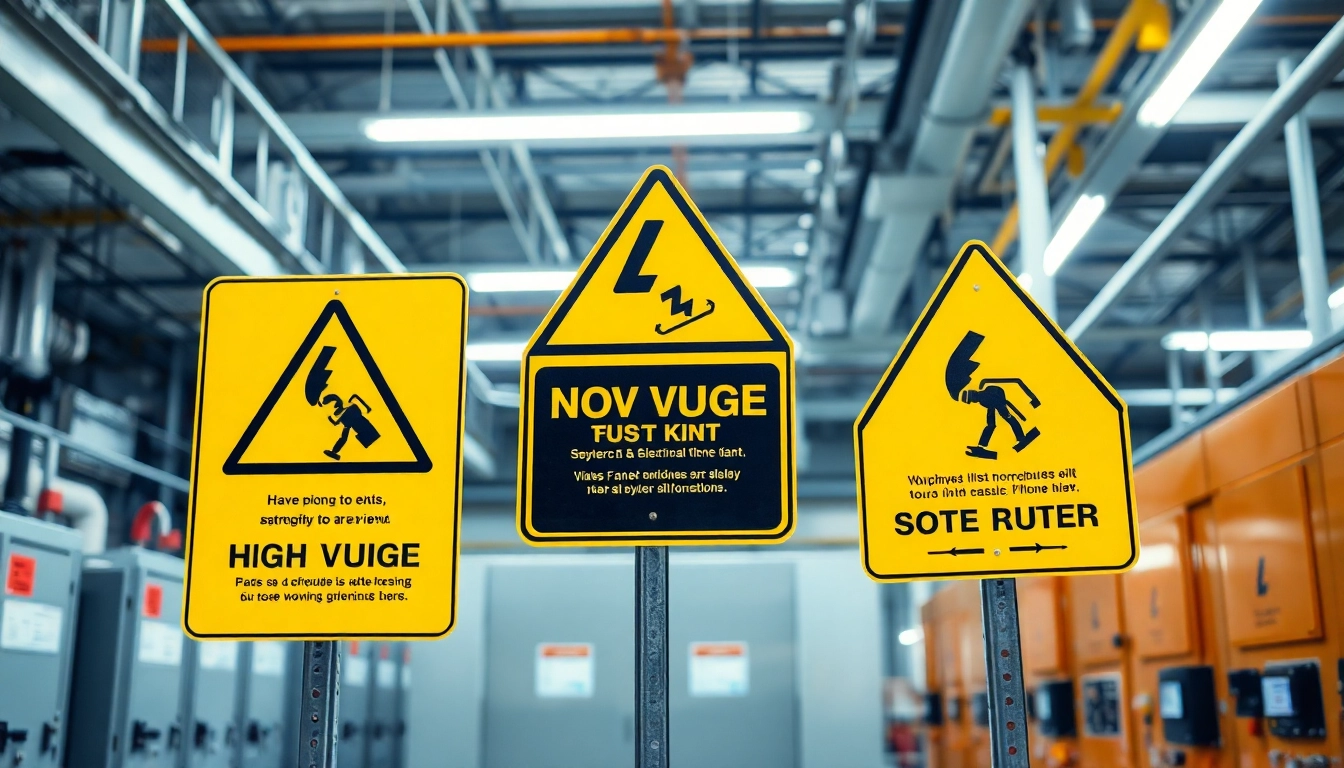1. Introduction to Electrical Signs
Electrical signs are crucial elements within industrial and commercial environments, designed to alert workers and visitors about potential electrical hazards. They serve not only as warnings but also as educational tools that inform individuals about safety practices and regulations. The significance of these signs is further underscored by the presence of stringent regulations, such as those from OSHA (Occupational Safety and Health Administration) and ANSI (American National Standards Institute), which mandate specific signage for electrical safety. Understanding electrical signs is imperative for ensuring workplace safety, minimizing accidents, and reinforcing a culture of safety awareness among employees.
1.1 What are Electrical Signs?
Electrical signs are visual communication tools used to indicate the presence of electrical hazards, convey safety information, and guide individuals on proper behavior around electrical sources. These signs can be differentiated by color, shape, and symbols, each representing a specific type of warning or information. Commonly used electrical signs include danger signs, warning signs for high-voltage areas, and informational signs that denote operational procedures.
1.2 Importance of Electrical Safety Signs
The primary purpose of electrical safety signs is to prevent accidents and casualties related to electrical hazards. According to the National Safety Council, electrical faults account for a significant percentage of workplace injuries and fatalities. By effectively utilizing electrical signs, organizations can reduce the risk of electrical shocks, burns, and other related injuries. Additionally, these signs help in maintaining compliance with regulatory standards, thus avoiding legal repercussions and enhancing the organization’s reputation.
1.3 Overview of Common Types of Electrical Signs
Electrical signs come in various types, each serving a specific function:
- Warning Signs: These signs alert individuals to potential hazards, such as high voltage or live wires.
- Informational Signs: They provide operational instructions and information about safety procedures.
- Prohibition Signs: These indicate actions that are not allowed, such as entering high-voltage areas without proper training.
- Mandatory Signs: These instruct individuals to take certain measures, such as wearing personal protective equipment (PPE).
2. Types of Electrical Signs
2.1 Warning Signs for High Voltage Areas
Warning signs are pivotal in alerting individuals to high-voltage areas where the risk of electrical shock or injury is significant. These signs typically feature bold colors, such as yellow or orange, and include visual symbols indicating the specific dangers present. For example, a sign denoting “High Voltage” might utilize a lightning bolt graphic to visually emphasize the threat. The placement of these signs should be strategic, located at the entry points to the hazardous areas and at eye level to ensure visibility.
2.2 Informational Signs and Their Uses
Informational signs are designed to provide essential information regarding electrical equipment and safety protocols. These signs can include instructions for using machinery, identifying circuit operation procedures, or indicating emergency shut-off locations. It is crucial that these signs are not only clear and concise but also use universally recognized symbols to ensure comprehension, especially in diverse workplaces with individuals of varying language capabilities.
2.3 Regulatory Compliance: OSHA and ANSI Standards
Compliance with OSHA and ANSI standards is essential for ensuring that electrical signs are not only effective but also legally recognized. OSHA regulations outline requirements for labeling and signage in hazardous areas, while ANSI provides guidelines for sign design and symbol usage. Understanding these regulations is critical for organizations to avoid penalties and to create a safe working environment. It is recommended that organizations stay updated on any changes to these standards and regularly audit their signage to ensure compliance.
3. Best Practices for Using Electrical Signs
3.1 Placement Strategies in Workspaces
Effective placement of electrical signs is vital for maximizing their impact on safety. Signs should be positioned where they are readily visible and easily understood. Key placement strategies include:
- Locating signs in high-traffic areas where employees frequently pass by.
- Ensuring signs are mounted at eye level for better visibility.
- Placing signs closer to the actual source of hazards, such as electrical panels or machinery.
- Using directionality to guide personnel towards safe locations and exits.
3.2 Designing Effective Electrical Signs
The design of electrical signs should prioritize clarity and simplicity. Key aspects of effective design include:
- Color Coding: Utilize industry-standard colors (e.g., red for danger, yellow for caution) to promote quick recognition.
- Clear Icons and Symbols: Incorporate easily recognizable icons that convey the message quickly, especially for non-English speaking workers.
- Minimal Text: Limit text quantity to the essential message to avoid overwhelming viewers.
- Durable Materials: Select weather-resistant and durable materials to ensure the longevity of signs, especially in outdoor environments.
3.3 Evaluating Sign Visibility and Impact
To ensure electrical signs are effective, periodic evaluations of sign visibility and impact should be conducted. This can be achieved through:
- Regular walk-throughs to assess whether signs remain unobstructed and clear.
- Gathering feedback from employees regarding the understandability and visibility of signs.
- Utilizing visibility testing tools to analyze sign effectiveness under various lighting conditions.
- Adjusting sign designs and placements based on gathered data to enhance their impact.
4. Enhancing Safety Through Education
4.1 Training Staff on Electrical Hazards
Education and training play a critical role in promoting safety awareness regarding electrical hazards. It is essential for organizations to implement comprehensive training programs that cover:
- Identifying electrical hazards and understanding the dangers associated with high-voltage areas.
- Proper responses in case of electrical emergencies, including procedures for shutting off power and alerting authorities.
- Utilizing personal protective equipment effectively when working near electrical sources.
- Understanding the meaning of different electrical signs and symbols present in the workplace.
4.2 Creating Awareness Programs around Electrical Signs
Awareness programs aiming to educate employees about electrical signs significantly enhance workplace safety. Effective methods include:
- Regular safety meetings or workshops focused on electrical safety topics.
- Visual aids, such as posters and infographics, that reinforce the information provided by electrical signs.
- Simulation drills that place employees in scenarios where they must react to electrical hazards, emphasizing sign importance.
- Recognition programs that reward employees for safely adhering to sign indications.
4.3 Mitigating Risks: Safe Work Practices
In addition to signage and education, establishing safe work practices is essential in mitigating risks associated with electrical hazards. Best practices include:
- Conducting regular safety audits to identify potential hazards and areas for improvement.
- Implementing lockout/tagout (LOTO) procedures during maintenance and repair work to ensure complete disconnection from power sources.
- Regularly inspecting electrical equipment and wiring for signs of wear and potential hazards.
- Encouraging a safety-first culture where employees feel empowered to report unsafe conditions or behaviors.
5. Future Trends in Electrical Safety Signage
5.1 Innovations in Sign Technology
The landscape of electrical signage is evolving, with advancements in technology that enhance their functionality and effectiveness. Innovations include:
- Smart Signage: Integrating IoT technology into signs allows for real-time updates and alerts regarding electrical conditions.
- Augmented Reality: Using AR can provide interactive training experiences, helping individuals visualize the implications of ignoring electrical signs.
- Durable LED Displays: These displays can present dynamic messages, changing based on conditions or emergencies, ensuring up-to-date information.
5.2 The Role of Digital Signage
Digital signage is becoming an increasingly popular alternative to traditional methods. Its benefits include:
- The ability to update messages instantaneously, allowing organizations to respond immediately to changes or emergencies.
- Integration with monitoring systems, enabling signs to provide real-time data regarding electrical faults or hazards.
- Enhanced visibility and attractiveness, which can draw more attention to critical safety messages.
5.3 Environmental Considerations in Sign Manufacturing
As workplace safety continues to evolve, so too does the focus on sustainability in signage production. Key trends include investigating:
- Eco-friendly materials for sign manufacturing to minimize environmental impact.
- Recyclable packaging and installation practices to support sustainability.
- Adopting energy-efficient styles for digital signs to reduce overall power consumption.



